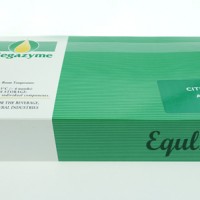A flexible and simple method for the rapid and reliable measurement of citric acid (citrate) in foods, beverages and other materials. Content: 72 assays per kit
UV-method for the determination of Citric Acid in foods,
beverages and other materials
Principle:
(citrate lyase)
(1) Citrate → oxaloacetate + acetate
(L-malate dehydrogenase)
(2) Oxaloacetate + NADH + H+ → L-malate + NAD+
(D-lactate dehydrogenase)
(3) Pyruvate + NADH + H+ → D-lactate + NAD+
Kit size: 72 assays (manual) / 720 (microplate)
/ 840 (auto-analyser)
Method: Spectrophotometric at 340 nm
Reaction time: ~ 5 min
Detection limit: 0.921 mg/L
Application examples:
Grape juice, wine, beer, fruit juices, soft drinks, tea, dairy products
(e.g. cheese), meat, processed meat, vegetable and fruit products,
bakery products, paper, pharmaceuticals, cosmetics and other
materials (e.g. biological cultures, samples, etc.)
Method recognition:
Methods based on this principle have been accepted by MEBAK, OIV,
EU, ISO2963, AOAC and IFU22
(Note: If the enzyme oxaloacetate decarboxylase is present in the sample, some
of the oxaloacetate product is converted to pyruvate. Therefore, to ensure citric
acid is measured quantitatively, D-lactate dehydrogenase (D-LDH) is employed
to efficiently convert any pyruvate produced into D-lactate and NAD+).
Advantages
Reconstituted citrate lyase stable for 4 weeks at 4°C / 6 months at -20°CBuffer / cofactor / enzyme tablets for efficient use of kit components
PVP incorporated to prevent tannin inhibition
Very competitive price (cost per test)
Mega-Calc™software tool is available from our website for hassle-free raw data processing
Standard included
Extended cofactors stability
Suitable for manual, microplate and auto-analyser formats





